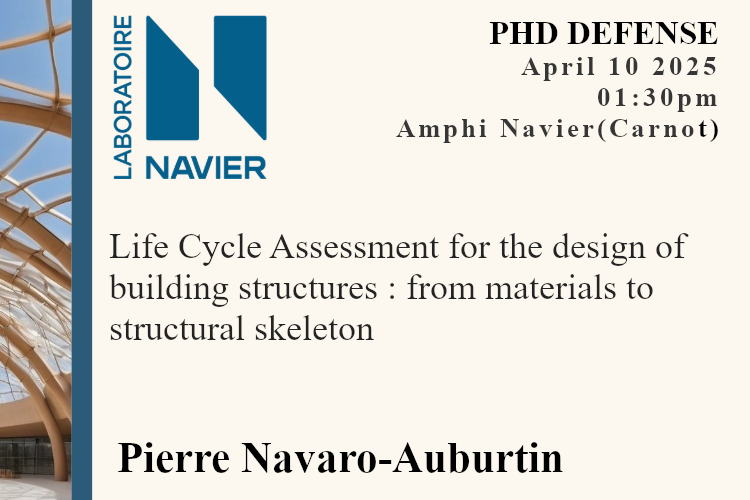
PhD Defense – Pierre Navaro-Auburtin
- Post by: sebastien.gervillers
- 3 April 2025
- No Comment
Pierre Navaro-Auburtin, a PhD candidate in the Architectured Materials and Structures team will defend his dissertation titled «Life Cycle Assessment for the design of building structures : from materials to structural skeleton » on Thursday, April 10 at 01:30 PM in the Navier amphitheater (Carnot).
Composition of the jury :
- Cécile BULLE – Professor, Université du Québec Montréal (Reviewer)
- Corentin FIVET – Professor, EPFL Lausanne (Reviewer)
- Catherine DE WOLF – Assistant Professor, ETH Zürich (Examinator)
- Nicolas PERRY – Professor, ENSAM Bordeaux (Examinator)
- Olivier Baverel –Professor, École Nationale des Ponts et Chaussées (Thesis Director)
-
Myriam SAADE – Researcher, CNRS Ingénierie Paris (Thesis Co-Supervisor)
-
Mathilde LOUËRAT – Project Manager, CSTB Grenoble (Thesis Co-Supervisor)
- Manuel Manthey – Engineer, CSTB (Thesis Co-Supervisor)
- Frédéric DUBOIS – Reserach Engineer, LMGC Montpellier (Guest)
- Raphaël MENARD – Architect-Engineer, AREP (Guest)
- Jean-Luc MARTIN – Engineer, AREP (Guest)
The defense will be broadcasted live
Abstract
The construction sector faces multiple crises: climate change, damage to ecosystem quality, human health issues, and intensive resource use. In this context, this thesis proposes to quantify the environmental impacts of building structures and identify ways to reduce these impacts. To address these questions, this manuscript proposes to couple two approaches: structural design and Life Cycle Assessment.
This method is developed on several scales. First, at the material scale. A synthesis of the literature is carried out, serving as a foundation for the rest of the manuscript. The idea is to evaluate the impact of each structural material on different environmental indicators and to analyze certain technologies to reduce these impacts.
The approach is then developed at the scale of structural elements such as beams, columns, and floors. These are the basic building blocks of the structural vocabulary, allowing the development of construction systems. Each element can be found in a variety of geometric configurations (span, height, shape) and loading. This will influence the quantity and type of material used and thus the environmental impacts. The aim of this part is to quantitatively evaluate this influence. It will also allow the exploration of new construction systems such as stone systems showing the interest of such systems.
The study then focuses on building construction systems. Classic building structures are composed using the previously described structural elements and materials. This scale allows for the consideration of the influence of the overall building geometry as well as the interactions between different structural elements. Since a building is not only composed of the structure, the influence of these choices on other parts of the building, such as energy, is evaluated.
Finally, an evaluation of the future impacts of structures is carried out. The arrival of environmental regulations pushes industries to find ways to reduce their greenhouse gas emissions and to produce decarbonization roadmaps. Based on these assumptions and prospective scenarios, the future environmental impact of structures is estimated. This allows, on the one hand, to guide a strategy regarding the materials to be developed for the sector, but also to evaluate the possible consequences of reducing the impact of climate change on other impacts.


